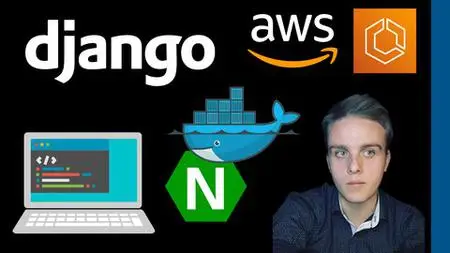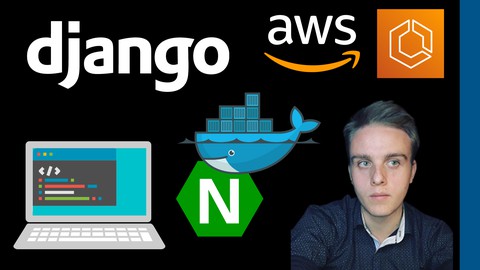Deploy A Django Web App With Nginx And Amazon Ecs - 2022
Last updated 10/2022
MP4 | Video: h264, 1280x720 | Audio: AAC, 44.1 KHz
Language: English | Size: 2.37 GB | Duration: 6h 36m
Last updated 10/2022
MP4 | Video: h264, 1280x720 | Audio: AAC, 44.1 KHz
Language: English | Size: 2.37 GB | Duration: 6h 36m
Create a Django web app with Docker and Nginx, and deploy it to Amazon ECS
What you'll learn
How to deploy your website using Amazon ECS and Docker
How to use AWS for deployment
How to build a mini Django application
How to deploy your static files to Amazon S3
How to host your postgres database on Amazon RDS
Requirements
Basic knowledge of Python, Django and AWS is required (especially on EC2)
Knowledge on Docker would be helpful, but it isn't mandatory for this course.
Description
Welcome! I'm here to help you to master the basics of deploying a Django web application to Amazon Elastic Container Service (ECS) whilst utilizing Nginx and Docker.This course is primarily intended for individuals who have a basic knowledge of Django and AWS. Knowledge on Docker would be helpful, but it isn't mandatory for this course.To put it simply, if you have a background in Django and AWS and want to learn about how to deploy your web application, then this is definitely the course for you!I want to help YOU master the art of deploying a Django application to Amazon ECS. The Deploy a Django web app with Nginx and Amazon ECS course has been structured in a simple and logical order. Everything that has been designed from the styling to the graphics and topics covered is crafted with the absolute duty of care towards the student. The main focus of the course is to teach you how to deploy your Django web application to Amazon ECS with Docker and Nginx.You will learn how to utilize several AWS services such as Amazon S3, Amazon RDS, Route 53, Certificate Manager, Elastic Container Service (EC2 - launch type) etc. You will also learn how to attach a domain name and SSL certificate to your web application. It is mixed with theory and practical hands-on demonstrations.The course is structured in a logical and cohesive way - not just random slides plastered everywhere.It starts off very simple and then builds on gradually throughout the course.You will also learn about the basics of Docker and containerizationThis course is jam-packed with lecture slides, PDF walkthroughs, code snippets/references and comes along with the full project source code - as a zip file.All 150 + slides are available as a downloadable PDF.The Deploy a Django web app with Nginx and Amazon ECS course is a highly practical course and allows you to apply your knowledge:There is a wealth of hands-on lectures throughout this course.You will be able to deploy your Django web application by containerizing it.–––––––––––––––––––––––––-Your instructor:My name is Arno Pretorius. I'm a qualified IT teacher who has taught programming both in-person and online. My main passions are teaching and technology, so I thought why not just combine the best of both worlds to create something truly amazing and valuable. Over the years, I have created and deployed many real-world Django-based applications, including a job portal for university graduates and an exclusive social network. I'm a Django developer, an AWS Solutions Architect Professional, Developer and an AWS Database Specialist. I have a keen interest in everything that relates to web development, Django web application security, and cloud computing.I'm also an Amazon author and have published books on Django web application security and basic web development. So, let's go and become fluent in Django deployment, along with an extra service or two. Trust me you are in good hands!–––––––––––––––––––––––––-This course also comes with:- 6.5 hours of on-demand video- Full lifetime access - A Udemy certificate of completion - Several downloadable resources - Access on mobile and TVJoin me in this course if you want to learn how to deploy your Django web application via containerization.
Overview
Section 1: Course Introduction
Lecture 1 Course welcome!
Lecture 2 Thought process
Lecture 3 Course overview
Section 2: Resources
Lecture 4 Code and slides - download
Section 3: Baseline Installation and setup
Lecture 5 Python installation and setup
Lecture 6 Visual Studio Code installation and setup
Lecture 7 VS Code extensions
Section 4: Create a basic Django web app
Lecture 8 Introduction - [PLEASE READ]
Lecture 9 Django project setup
Lecture 10 Configure the python interpreter
Lecture 11 Django app setup
Lecture 12 Templates, URL's and Views
Lecture 13 Configure static files
Lecture 14 Static Files - Manually refresh your static files by clearing the cache
Lecture 15 Styling our web app - Part 1
Lecture 16 Styling our web app - Part 2
Lecture 17 Create a profile model
Lecture 18 Configure Django to allow file uploads
Lecture 19 User registration
Lecture 20 User authentication
Lecture 21 Profile management: Updating our username and email
Lecture 22 Profile management: Deleting an account
Lecture 23 Upload and render a file in Django
Section 5: IAM users, Databases and static files
Lecture 24 Create an AWS account
Lecture 25 AWS Budgets - Create a designated budget
Lecture 26 AWS Identity and Access Management - Theory review
Lecture 27 Create an AWS IAM user and sign in as an IAM user - Part 1
Lecture 28 Create an AWS IAM user and sign in as an IAM user - Part 2
Lecture 29 Add ECR + ECS permissions [IMPORTANT]
Lecture 30 [OPTIONAL] - How to enable MFA for your root and IAM user account
Lecture 31 Amazon S3 - Theory review
Lecture 32 Deploy our static files to an Amazon S3 bucket
Lecture 33 Amazon RDS - Theory review
Lecture 34 Create and connect to an Amazon RDS postgres database
Lecture 35 Styling the admin page - Solution 1
Lecture 36 Styling the admin page - Solution 2
Section 6: Domain name and SSL certificate [IMPORTANT]
Lecture 37 AWS Route 53 - Theory review
Lecture 38 COST REMINDER!
Lecture 39 Register a domain name with Route 53
Lecture 40 Amazon Certificate Manager - Theory review
Lecture 41 Provision and assign an SSL certificate
Section 7: Docker
Lecture 42 What is Docker?
Lecture 43 Managing docker containers on AWS - Theory overview
Lecture 44 Running docker containers on Amazon ECS
Lecture 45 Installing and setting up Docker
Lecture 46 Examine Docker desktop
Lecture 47 Sign up for a Docker Hub account
Lecture 48 Nginx: A short introduction
Lecture 49 What is a reverse proxy?
Lecture 50 Installing important packages
Lecture 51 IMPORTANT NOTE!
Lecture 52 Create a requirements.txt file
Lecture 53 Creating our docker files - Theory overview
Lecture 54 Create a docker file for our docker image - Part 1
Lecture 55 Create a docker file for our docker image - Part 2
Lecture 56 Create a docker-compose file
Lecture 57 Build our docker images
Lecture 58 Running our docker container locally
Lecture 59 Stopping a docker container and clearing the cache
Lecture 60 Docker cleanup
Section 8: Deploy our web app to Amazon ECS
Lecture 61 Deployment prep - Pt. 1
Lecture 62 Deployment prep - Pt. 2
Lecture 63 Just an extra tip!
Lecture 64 Security tips!
Lecture 65 Deployment Introduction
Lecture 66 COST REMINDER!
Lecture 67 Push our docker images to Amazon ECR
Lecture 68 IMPORTANT NOTE!
Lecture 69 Deploy our Django web app to Amazon ECS - Part 1
Lecture 70 IMPORTANT NOTE!
Lecture 71 Deploy our Django web app to Amazon ECS - Part 2
Section 9: Managing user sessions [OPTIONAL]
Lecture 72 Amazon ElastiCache - Theory review
Lecture 73 How to manage user sessions?
Lecture 74 What is a sticky session?
Lecture 75 How to enable sticky sessions
Lecture 76 Section cleanup
Section 10: Thank you!
Lecture 77 THANK YOU! - A final message
Lecture 78 Bonus lecture!
Mid - advanced python developers with a basic knowledge of Django,Developers who want to deploy their Django web application,Django + AWS deployment enthusiasts



